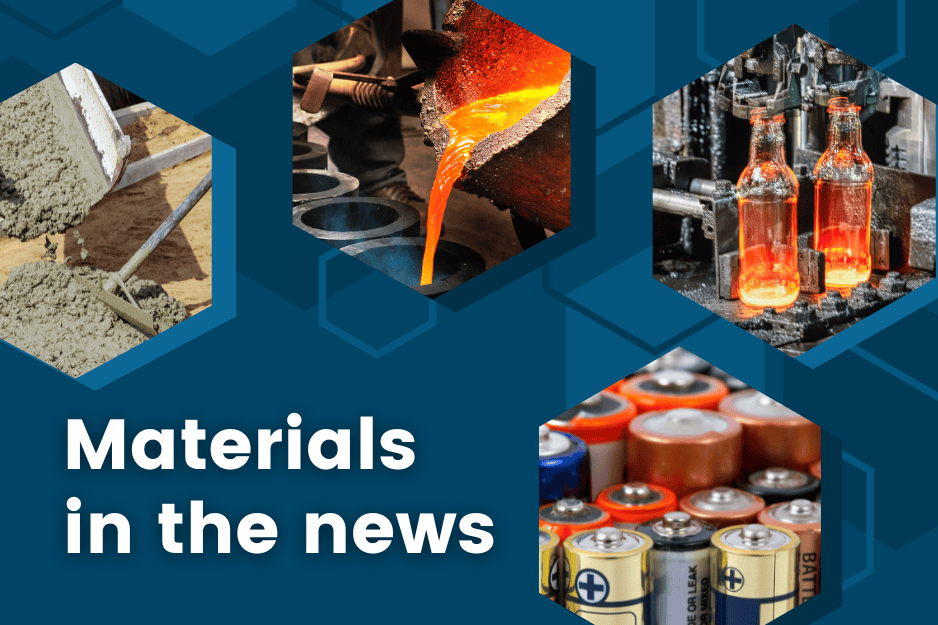
[Image above] Credit: ACerS
ENERGY
Cement that can cool itself by scattering heat
Researchers from Southeast University in China developed a metasurface-enhanced cement that scatters sunlight instead of absorbing it. The cement achieved high solar reflectance (96.2%) and blackbody-like emissivity (96%) in the long-wave infrared spectrum.
Concrete ‘battery’ now packs 10 times the power
Thanks to optimized electrolytes and manufacturing processes, Massachusetts Institute of Technology researchers increased the energy storage capacity of their electron-conducting carbon concrete supercapacitors by an order of magnitude.
Lighting the way for electric vehicles by using streetlamps as chargers
Researchers at The Pennsylvania State University created a scalable framework to develop, analyze, and evaluate using streetlights as a low-cost, equitable electric vehicle charging option.
Cobalt exsolution technique boosts solid oxide fuel cell performance
Hanbat National University researchers presented the first experimental evidence of cobalt exsolution in oxidizing conditions. This discovery presents a new direction for developing stable and high performance solid oxide fuel cells.
Researchers create electrode-agnostic electrolyte
University of Wisconsin-Madison engineers introduced an electrolyte design strategy for sodium metal batteries that directs 2-methyltetrahydrofuran to the sodium metal electrode and tetrahydrofuran to the NaNi1/3Fe1/3Mn1/3O2 positive electrode interface, optimizing stability for both electrodes.
MANUFACTURING
Technique makes complex 3D printed parts more reliable
Massachusetts Institute of Technology researchers created a way for models to account for 3D printing’s limitations during the design process. Their algorithm not only includes information about the print nozzle size, it also incorporates the direction of the print head and the impact of weak bonding between layers.
Breakthrough in 3D printing glass without glue
Hebrew University of Jerusalem researchers presented a binder-free method for 3D printing silica glass. When exposed to light, their material undergoes a controlled chemical transformation, solidifying without the need for binders.
Researchers discover part of electron that drives catalysis
Researchers from the University of Minnesota Twin Cities and the University of Houston measured the fraction of an electron that makes catalytic manufacturing possible. This behavior has been theorized for over a century, but until now, direct measurements have never been directly observed.
Rolling back the years: Ball milling enjoys renaissance
It is a 19th century invention: a rotating cylinder filled with steel ball bearings, designed to grind materials into powder. Yet ball milling—and the field it belongs to, mechanochemistry—is enjoying a renaissance, reports a Cosmos article.
OTHER STORIES
Electrically driven perovskite laser
Zhejiang University researchers invented an electrically driven perovskite laser. The device shows a lasing threshold of 92 A/cm2, which is an order of magnitude lower than that of the best electrically driven organic lasers. It can also be rapidly modulated at a bandwidth of 36.2 MHz.
DNA circuits store data—with heat as their power source
Researchers created DNA circuits that could be charged and recharged by cycling the temperature of the system. At high temperatures, the molecules become single-stranded, but when the system cools, the circuit resets to its original state.
Author
Lisa McDonald
CTT Categories
- Weekly Column: “Other materials”
Related Posts
Other materials stories that may be of interest for December 10, 2025
December 10, 2025
Other materials stories that may be of interest for December 3, 2025
December 3, 2025
Other materials stories that may be of interest for November 26, 2025
November 26, 2025